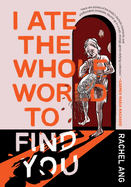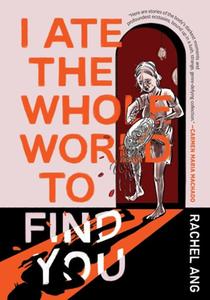
 Australian artist/writer Rachel Ang's compelling I Ate the Whole World to Find You gathers five loosely interrelated stories exploring a young woman's evolving relationships--romantic, platonic, familial. Ang draws black-and-white panels of assorted sizes, including full-pages, boxed inserts, symmetrical divisions of two, four, six, as if repeatedly imposing order on emotional experiences and difficult confrontations. Where Ang places their text bubbles--often outside the panels--seems to underscore the inevitable unpredictability of real-life conversations.
Australian artist/writer Rachel Ang's compelling I Ate the Whole World to Find You gathers five loosely interrelated stories exploring a young woman's evolving relationships--romantic, platonic, familial. Ang draws black-and-white panels of assorted sizes, including full-pages, boxed inserts, symmetrical divisions of two, four, six, as if repeatedly imposing order on emotional experiences and difficult confrontations. Where Ang places their text bubbles--often outside the panels--seems to underscore the inevitable unpredictability of real-life conversations.
"Hunger" opens the collection, introducing Jenny, who works in a warehouse stocking inventory. Sharing failed relationship anecdotes with co-worker Jack eventually leads to his revealing his preferred "type," exposing a sexual fetish that Jenny initially accepts without outward judgment. When the pair become involved, Jack, who loves to cook, (over)feeds Jenny, who starts to feel suffocated. In "The Passenger," Jenny travels on a train with a couple with whom she is having trouble communicating; she turns "into some silent interior part of myself," berating herself for being "revolting... wholly unlovable." But as their failure to communicate devolves into a dreamscape, her rebuffed attempts to talk to her angry ex-partner make her realize, "I can't stay here. I gotta go."
A phone call from her cousin sends Jenny into memories of a shared past in "Your Shadow in the Dark," with utterly shattering revelations. A date at the pool with an old friend in "Swimsuit" turns tragic: "I don't know what we just saw... and we didn't do anything! We just let it happen." In the closing "Purity," pregnancy offers Jenny a chance to "start anew, pure" with another soul: "A connection far deeper, wider, purer, than the limited frame of language." Communication beyond the womb, however, "is easily jammed by external frequencies"--a condition Ang cleverly manifests with unexpected spatial scrambling within the conversation bubbles: "Th s n ottalk ng no sen e i sn't nor mal a d i s n t ok," Jenny's partner insists; "Te n centi metre sd ilat ed now," maternity staff announce. Despite being afraid, Jenny creates life.
Ang's narrative is textually minimal. Their expressive art builds layers of meaning not reliant on extensive words. "This is how I build a way out," for example, is an otherwise wordless, two-page how-to that Jenny must devise to create her own escape. "It's like no one knows what to do with women's bodies," a character comments. Step-by-step, panel-by-panel, amid complications and challenges, Ang enables Jenny to painfully, tenaciously, figure out her own self. --Terry Hong
Shelf Talker: Australian comics creator Rachel Ang poignantly, hauntingly explores a young woman's journey toward self-realization through her relationships with lovers, friends, and family.

